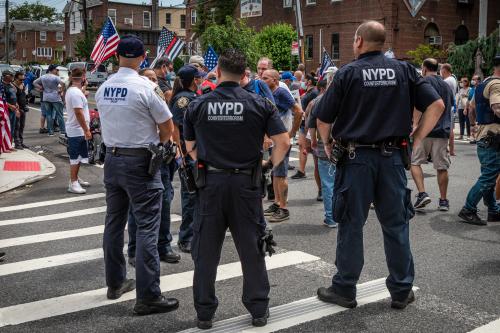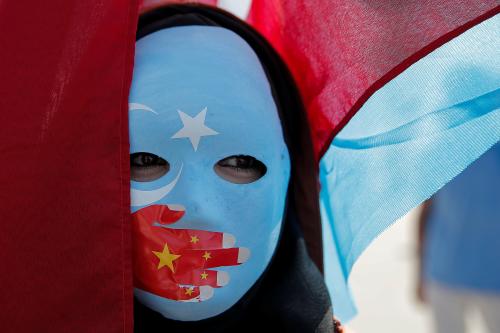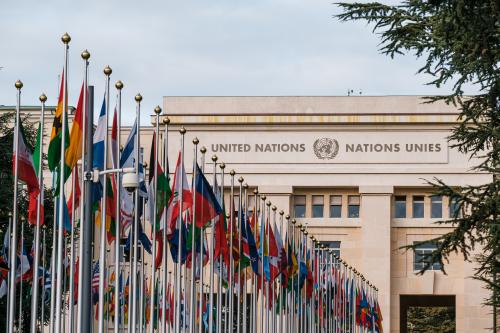Following President Trump’s election, the consensus was that his anti-immigrant and Islamophobic rhetoric would significantly alter the trajectory of U.S. “countering violent extremism” (CVE) approaches both at home and abroad. That trajectory had started to gain momentum during the last years of the Obama administration, particularly following the emergence of ISIS as a global phenomenon in 2014. The approach recognized that battlefield successes alone would not prevent the group’s growth or re-emergence, and that more attention was needed on the drivers — and not just the manifestations — of terrorist violence, both in the Middle East and beyond.
Nearly four years into the Trump administration, what is its record on international CVE efforts? Much ink has already been spilled regarding the Trump-era approach to violent extremism at home, in light of the rise in white supremacist violence and accusations that the president has fanned the flames.
In the meantime, the administration’s international CVE efforts have largely escaped scrutiny. There, the record is uneven at best — characterized by a lack of consistent leadership, strategy, coordination, coherence, and prioritization, as well as ad hoc decisions by individual political appointees rather than by a concerted effort to dismantle the Obama-era international CVE agenda.
A scattered approach
On the one hand, a cadre of dedicated civil servants across the U.S. government, who believed in CVE and were committed to its preservation, managed to convince the White House to include many of its key principles, albeit not the term “CVE,” in the 2018 National Strategy for Counterterrorism. In fact, rather than dismissing the preventative approach that formed a core part of CVE, the document called for its strengthening. It committed the United States to lead efforts to create a “global [terrorism] prevention architecture with the help of civil society, private partners, and the technology industry” to thwart terrorist radicalization and recruitment,” underscoring that “prevention works. It can save lives.”
Yet, it does not appear that the administration made any effort to operationalize this call, apart from the occasional mention by State Department and U.S. Agency for International Development (USAID) officials. Instead, the White House preferred to focus on the need to eradicate terrorists and the ideology it believes fuels them. At the same time, the Trump administration turned a blind eye to regimes such as Egypt and Saudi Arabia that use specious counterterrorism arguments to crack down on political opponents and independent civil society.
Meanwhile, while the State Department’s counterterrorism funding has withstood the department’s budget cuts during the Trump era, funding for international CVE efforts have declined dramatically during this period. It was reduced by more than 50% from President Obama’s last budget request ($174 million) to President Trump’s FY21 request ($70 million). Further, Trump appointees shelved the first-ever joint State Department-USAID CVE strategy the Obama administration rolled out in 2016. Such a framework started to connect CVE’s disparate, diplomatic, programming, and research dimensions and sought to ensure the various regional and thematic bureaus across these two agencies — not to mention U.S. embassies around the globe — were promoting a consistent, coherent, and data-driven CVE vision.
However, the Trump team never replaced the strategy with one of its own, likely believing it did not merit such attention at the top. As a result, different bureaus continued to support CVE projects from Bosnia to Bangladesh, Kenya to Kazakhstan, and Tunisia to Trinidad and Tobago, but not within the framework of a coherent (let alone single) strategy.
So there was no longer an agreed strategy in place to coordinate, and the Obama-era international CVE mechanism — which brought together representatives of State, USAID, and inter-agency stakeholders to coordinate implementation and routinely assess progress and resource allocations — has atrophied. In fact, the department’s inspector general recently found that CVE funds across the department were not adequately coordinated or spent with goals of countering violent extremism.
The Bureau of Counterterrorism removed “CVE” from its title, signaling its de-prioritization of the issue. It refuses to even use the term “violent extremism” when engaging with foreign counterparts on how to crack down the global rise of what various other U.S. government entities refer to as “racially or ethnically motived violent extremism.” Instead, the bureau uses “racially or ethnically motivated terrorism,” despite the confusion this sows with foreign partners who are also engaging with U.S. domestic agencies.
Moreover, the bureau embraced outdated approaches to addressing violent extremism that emphasize ideology, religion, and counter-messaging that are more line with the views of authoritarian and other repressive regimes than those of its longstanding democratic allies. The priority has been, as the State Department’s Counterterrorism Coordinator has said, “to counter the underlying ideas that give rise to [extremist violence]” and to “engage in a contest of ideas.” This means, for example, working closely with Saudi authorities “to develop new capabilities to ‘monitor and counter extremist messaging,’” including through the Saudi-run Global Center for Combatting Extremist Ideology. Likewise, administration officials have lauded the work of the Mohammad VI Institute for Training of Imams in Morocco, which focuses on delivering a “moderate religious curriculum to create community religious leaders that disrupt Islamist ideology [and] promoting authentic voices that are committed to pluralism and human rights, and that can speak credibly to those at risk of buying into terrorist ideology.” These approaches all but ignore research showing that the more relevant drivers of extremist violence often involve how governments treat their citizens: human rights abuses, governance deficits, inequality, marginalization, and exclusion.
The bureau’s narrow view of CVE has hindered its ability to contribute to the growing movement within the United Nations, the World Bank and other development institutions, and the donor community to view CVE as part of a wider conflict and violence prevention effort that examines drivers and goes beyond the heavily securitized post-9/11 approach.
A better way
The need for a new approach to violent extremist threats around the globe motivated the work of the 2019 U.S. Institute of Peace Task Force on Extremism in Fragile States. Some of the task force’s recommendations were included in the bipartisan Global Fragility Act (GFA), signed into law last December. These initiatives, which complement multilateral efforts within the U.N. and World Bank, focus attention on the critical role the State Department needs to play in implementing them. However, State Department counterterrorism officials have shown little appetite for participating in GFA implementation discussions — asserting that the counterterrorism bureau doesn’t do “prevention” and preferring to charge ahead with its own, narrowly-scoped strategy.
But this approach is at odds with the one that career professionals at USAID developed when they updated the agency’s 2011 CVE policy this year. The update was part of a concerted effort to learn lessons from international CVE efforts over the past decade and deepen the agency’s involvement in those efforts. Former USAID Administrator Mark Green signed off on the new policy just before resigning in April 2020, which had backing from the National Security Council staff: It integrates its CVE efforts into wider conflict and violence prevention efforts and emphasizes the importance of local partner capacity-building to address threats and build resilience within their communities. However, recently-appointed Trump ideologues within the agency — who favor a more narrow focus on “radical Islamic extremism” and are trying to reduce and reorient the agency’s CVE and wider conflict prevention work — so far have prevented its public release. They have also stymied continued USAID involvement in the international CVE community of practice for development actors it helped launch in 2016. This highlights the all-too-familiar gap during the Trump administration between the government professionals who are eager to learn the lessons of counterterrorism and CVE work, and the political appointees who sometimes brandish anti-Muslim rhetoric instead.
Yet, there are two important areas where the government professionals seemed to prevail. The first is in continued support for the international CVE architecture, much of which was developed during President Obama’s tenure. Despite the current administration’s skepticism and even disdain for multilateralism, U.S. funding support for and diplomatic engagement in a range of multilateral CVE institutions — such as the Global Community Engagement and Resilience Fund and Strong Cities Network, which continue to receive strong support from U.S. allies and partners — has remained steady. The second is the administration’s commitment to help countries develop what are often community-led programs to support the rehabilitation and reintegration of ISIS family members returning from detention camps in northeast Syria and those looking to exit terrorist groups. Few would have imagined this kind of support from an administration whose leader proposed killing terrorists’ family members during the 2016 campaign.
Slapdash results
The overall Trump administration record on international CVE remains checkered at best. However, anti-Muslim rhetoric did not give way to a coordinated policy change across government. There never was any directive from the White House, let alone the secretary of state, to systematically undo the international CVE efforts and dismantle global CVE architecture that was largely the brainchild of the previous administration. Instead, most of the damage resulted from ad hoc decisions taken by individual Trump appointees. These scattered decisions — many of which have left the United States out of step with an international CVE agenda that has broad support from U.S. allies, the U.N., and other multilateral bodies — can and should be reversed or ignored if President Trump is voted out of office in November.








Commentary
International efforts to counter violent extremism under President Trump: A case study in dysfunction and incoherence
September 9, 2020